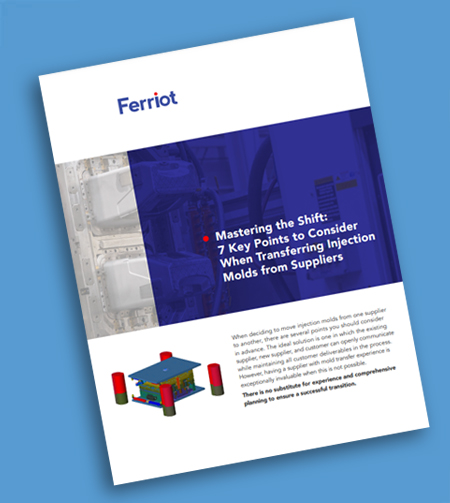In competitive industries, product differentiation is more important than ever. A pad printing machine allows manufacturers to add high-resolution graphics, logos, or instructional text directly onto injection molded parts — enabling precise, consistent customization even on irregular or curved surfaces.
For OEMs, this capability isn’t just about aesthetics. Custom markings can support branding, regulatory compliance, and usability, helping products stand out while meeting strict functional requirements. In this blog, we’ll explore the benefits of pad printing, its practical applications across industries, and how Ferriot leverages in-house pad printing machines to deliver fully integrated, customizable solutions for complex injection molded components.
What is a Pad Printing Machine?
A pad printing machine is a specialized tool that transfers ink from an etched plate onto the surface of a molded part using a soft silicone pad. This method allows graphics, text, or logos to be applied with high precision, even on irregular, curved, or textured surfaces that are challenging for other printing techniques.
Unlike screen printing or direct-to-part digital methods, pad printing maintains consistent image quality across complex geometries, making it an ideal solution for injection molded components where both accuracy and repeatability are critical. Its adaptability enables manufacturers to achieve sharp, durable prints without compromising part integrity.
Benefits of Pad Printing for OEMs
Pad printing offers several advantages for OEMs looking to enhance both functionality and aesthetics:
- Branding and logos: Easily add distinctive branding elements that reinforce market differentiation.
- Instructional text and compliance markings: Apply critical product information, safety warnings, or regulatory identifiers with precision.
- Precision and durability: Achieve high-resolution, long-lasting prints that withstand repeated use and cleaning.
- Flexible production runs: Whether for small prototypes or high-volume manufacturing, pad printing accommodates a wide range of quantities efficiently.
These benefits help OEMs meet both design and compliance requirements without slowing production or increasing complexity.
Applications Across Industries
Pad printing is a versatile solution used across multiple industries where clarity, durability, and customization are essential.
In the medical device sector, for instance, it provides durable labeling for buttons, indicators, and housing components, ensuring that critical information remains legible throughout the product’s lifecycle.
Electronics manufacturers also rely on pad printing for compliance markings, serial numbers, and functional identifiers on enclosures or panels.
Business equipment OEMs use it to add logos, operational symbols, and instructional graphics that enhance usability and brand recognition.
And industrial equipment applications benefit from the process as well, with prints that can withstand harsh environments, including exposure to chemicals, UV light, and repeated handling. Integrating pad printing into production allows OEMs to achieve consistent, high-quality results even on complex, curved, or textured parts.
Pad Printing vs. Other Decoration Methods
While pad printing excels in precision and adaptability, it is helpful to consider how it compares to other decoration methods.
Hot stamping, for example, uses heat and foil to produce durable, metallic-looking graphics, often used for compliance labeling or premium branding. Digital printing offers high-resolution, full-color images and is particularly suited for large flat surfaces or applications that require variable data. Spray painting covers extensive areas with uniform color or texture but lacks the fine detail achievable with pad printing.
Pad printing distinguishes itself by transferring intricate designs onto curved, irregular, or textured surfaces, making it the preferred method when detail, accuracy, and durability are critical. Other techniques may be more suitable for large-scale graphics or specialized finishes, but pad printing remains the most reliable option for complex part geometries.
Ferriot’s Pad Printing and Secondary Services
Ferriot offers in-house pad printing capabilities that bring precision and flexibility to your injection molded parts. By integrating pad printing with services such as painting, decorating, and assembly, we help OEMs streamline production, reduce the number of vendors, and maintain consistent quality across every part. This end-to-end approach ensures that your customized components not only meet aesthetic and functional requirements but are also delivered efficiently and reliably.
Need greater customization for your injection molded parts? Talk to our team today to see how we can support your next project.



